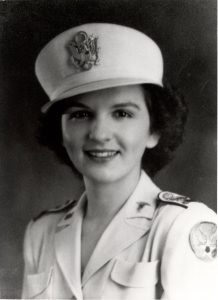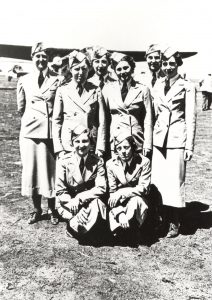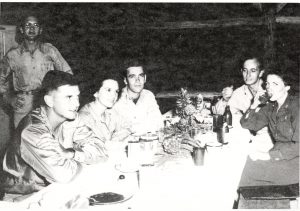Seventh in a Series of Ten Blogs offering A Short History of Nursing from antiquity through the mid-twentieth century. Part 1 – From Sacred to Secular – covers nursing in ancient
times through the Crimean War. Part 2 – From Civilian to Military – continues with
the establishment of the Saint Thomas School of Nursing through World War II.
A Short History of Nursing
Through World War II
Part 2 From Civilian to Military Nurses
The American Civil War
When the southern states seceded from the Union (North) after President Abraham Lincoln vowed to prohibit slavery in western territories not yet made states, and Fort Sumter in South Carolina fell to the Confederacy (South) in 1861, igniting the Civil War, the armies of both sides were caught unprepared as casualties quickly overwhelmed the initially meager military medical facilities. The recent publication of Nightingale’s Notes on Nursing in America (1860) with its message in her Preface that “every woman must at some time or other of her life, become a nurse” led thousands of women, most with no previous experience but drawn by the Nightingale legacy, to offer their services as nurses in military hospitals. 1 Because America had no formal nurse training at that time, no criteria existed by which to define a nurse. 2 But like their sisters in England, these women had experience nursing family members and neighbors in their homes. Some of these nurses are well known: Louisa May Alcott, whose book Hospital Sketches (1863) depicts her six weeks of nursing, cut short by illness, at Union Hotel Hospital in Washington, D.C.; Clara Barton, founder of the American Red Cross, who primarily nursed soldiers near the front lines in camps and on battlefields; and Walt Whitman, whose poem The Wound Dresser (1865) depicts the more graphic details of his work as a nurse and self-appointed hospital missionary in Washington, D.C.
The same restrictions that Victorian women encountered in England were applied in nineteenth-century America, where society tried to define appropriate spheres for women and for men, with the former relegated to domestic circles and tasks. But, as was the case in England, American women saw nursing in military hospitals as an extension of their domestic duties now applied to soldiers who were someone else’s husband, son, or brother. The nurses, in turn, were surrogates for the wife, mother, or sister left back home when the war began.
The Secretary of War appointed Dorothea Dix as Superintendent of Women Nurses for the Union with authority to hire and assign nurses for both the government and the civilian United States Sanitary Commission (USSC), an agency that drew on lessons learned from a similar commission formed in the Crimean War. Dix, who thought her standards echoed those of Nightingale, established strict qualifications for applicants regarding age, appearance, and manner of dress. Equally important were good health, respectability, and compliance with regulations. Motherhood and maternal instincts were highly prized in the ideal nurse.
Emily Galik considered Dix unable to transfer the skills she had honed as an advocate for the mentally ill to her new position; according to Richard Harwell, Dix was “more authoritarian than authoritative in her administration.” 3 Her failure to convince – Galik says “compel” – medical officers to work with her women nurses resulted in a compromise that let Dix select the nurses but allowed medical officers to choose the nurses for their work places. 4 In a policy reminiscent of the ward system of nursing in England that the Nightingale system had replaced, the senior medical officer had the authority to direct the nurses’ duties and discharge the women “when considered supernumerary, or for incompetency, insubordination, or violation of his orders.” 5
That Dix did not even have the support of her nurses, who thought her criteria for selection out-dated, did not bode well for her tenure as Superintendent. Nurses from North and South found ways to circumvent the system of hiring and assignment. System? “There never was any system,’ Jane Stuart Woolsey, a nurse for Union soldiers claimed.
Hospital nurses were of all sorts, and came from various sources of supply; volunteers paid or unpaid; soldiers’ wives and sisters who had come to see their friends, and remained without any clear commission or duties; women sent by State agencies and aid societies; women assigned by the General Superintendent of Nurses; … These women were set adrift in a hospital, eight to twenty of them, for the most part slightly educated, without training or discipline. 6
As was the case in the Crimean War, response to the arrival of women nurses in Civil War military hospitals was mixed. Some surgeons who resented interference with the standard of care that the patients were receiving from male orderlies and surgeons alike reacted predictably, finding fault with the War Department’s decision to staff military hospitals with women and with the women themselves. Army surgeon John Brinton, who felt besieged by the newcomers, was vocal in his opposition to the Protestant women nurses: “Can you fancy half a dozen or a dozen old hags, for that is what they were (our modern efficient trained nurses were unknown), surrounding a bewildered hospital surgeon each one clamorous for her little wants? … I determined, therefore, to try to get rid of them from the Mound City [Illinois] hospital.” 7
And that he did, filling the nursing positions with Catholic Sisters, whom some surgeons preferred as being disciplined, more tractable, and less meddlesome. Mary Livermore, a nurse and assistant manager with the USSC, whose work took her to the Mound City hospital, quotes an unnamed surgeon who might have been Brinton as saying: “Your Protestant nurses are always making a fuss, spying out some mare’s-nest in a hospital, and writing home that this patient is abused, that one badly treated, or the other starved; that the surgeon gets drunk, or misappropriates the sanitary stores sent to him, or some other bugaboo story, and that’s why I won’t have them in my hospital.” 8
The American Medical Times had made its position regarding women nurses in military hospitals clear when the editor stated that “she is better adapted than man to prepare food for the sick, to preserve cleanliness of the wounds, and of the beds, and to regulate and keep in order whatever relates to the domestic appointments of a hospital.” 9 Laundries and diet kitchens were her forte. When nurse Phoebe Yates Pember was uncertain of her special duties for the hundreds of patients awaiting her in Confederate hospitals, “one mental spectrum always presented itself – chicken soup. … Nature may not have intended me for a Florence Nightingale, but a kitchen proved my worth.” 10
But correspondent S. G., whose letter appeared in the same issue of American Medical Times, was of a different opinion. “Our women appear to have become almost wild on the subject of hospital nursing,” he wrote, but even “with the best intentions in the world” they “are frequently a useless annoyance.” He cited a delicate, refined lady’s lack of physical strength when needed to assist a rough soldier with necessary tasks involving heavy lifting and bodily fluids. He conceded, however, that these “noble, sensible, tender-hearted women” could be useful in administering prescribed medications and providing the “delicate, soothing attentions which are always so grateful to the sick.” 11 For those who thought the refining influence of a lady nurse among sick and wounded soldiers on the ward a good thing, however, others thought her presence was ill-advised.
Although women nurses were accepted only grudgingly if at all in many military hospitals, they were welcomed on hospital ships. The Union government, USSC, and Western Sanitary Commission all maintained fleets of hospital transports that sailed the Potomac and Mississippi Rivers and their tributaries to pick up and transport patients to hospitals in St. Louis or to cities in the North. Lady nurses were a godsend to Frederick Olmsted, the mastermind behind the USSC hospital transport program. 12
“I often feel the pleasantness of our footing among all these persons, – official, military, naval, and medical,” wrote Katherine Wormeley on board the Wilson Small with the USSC in 1862, attesting to the congenial relationships among staff members on the hospital transport ships. “They clearly respect our work, and rightly appreciate it.” 13 She summed up the prevailing attitude of the Civil War women nurses, for whom fate had intervened to expand their horizons beyond the home circle:
As for the ladies among whom my luck has thrown me, they are just what they should be, – efficient, wise, active as cats, merry, light-hearted, thoroughbred, and without the fearful tone of self-devotion which sad experience makes one expect in benevolent women. We all know in our hearts that it is thorough enjoyment to be here, – it is life, in short; and we wouldn’t be anywhere else for anything in the world. 14
Wormeley’s tribute to her lady colleagues speaks to the eagerness with which they pursued the opportunities afforded them because of the war. Whether on land or on water, nurses showed their worth in situations that society previously had considered too taxing to woman’s delicate nature.
Zoë Hill notes that “War allowed women to test the boundaries of gender constraints that restricted their lives.” 15 The American Civil War marked the first large-scale movement of women into male-dominated public spaces and laid the foundation for the acceptance of women in future wartime work. When World War I broke out fifty years later, American and British women served in record numbers as nurses with their respective militaries near the front lines in France. But in the interim, two shorter wars in which the United States and Great Britain were involved moved nursing on both sides of the Atlantic one step closer toward the professionalism to which it aspired.
To learn how the history of nursing was reflected on the opera stage, see Judith Barger, The Nurse in History and Opera: From Servant to Sister (Lexington Books, 2024).
Notes
- Florence Nightingale, Notes on Nursing: What It Is, and What It Is Not (London: Harrison, 1859), v. The first American edition was published by D. Appleton and Company of New York in 1860.
- Formal nurse training based on the Nightingale system was implemented at Bellevue Hospital School of Nursing in New York City beginning in 1873; by the 1880s, the United States had twenty-two nursing schools.
- Kate Cumming, Kate: The Journal of a Confederate Nurse by Kate Cumming, ed, Richard Barksdale Harwell (Baton Rouge: Louisiana State University Press, 1959), xiii; Emily Galik, “Dorothea Dix, Superintendent of Nurses: When an Activist Becomes an Administrator,” Women Leading Change (Newcome College Institute, Tulane University) 2 (1) (2017): 35, accessed 12 November 2023, https://journals.tulane.edu/ncs/article/view/1143.
- Galik, “Dorothea Dix,” 35; E. [Edward] D. Townsend, “‘General Orders, No. 351’, Adjutant General’s Office, Washington, October 29, 1863,” General Orders, War Department, 1861, 1862, 1863, vol. 2 (New York: Derby and Miller, 1864), 568.
- Townsend, “General Orders, No. 351,” 568.
- Jane Stuart Woolsey, Hospital Days: Reminiscences of a Civil War Nurse (New York: Nostrand, 1868), 41.
- John H. Brinton, Personal Memoirs of John H. Brinton (New York: Neale, 1914), 44.
- Mary A. Livermore, My Story of the War: A Woman’s Narrative of Four Years Personal Experience as Nurse in the Union Army, and in Relief Work at Home, in Hospitals, Camps, and at the Front, During the War of the Rebellion (Hartford, CT: Worthington, 1890), 224.
- “Female Nurses in Military Hospitals,” American Medical Times 3 (13 July 1861): 25–26.
- Phoebe Yates Pember, A Southern Woman’s Story (New York: Carleton, 1879), 19, 21.
- S. G., “Duties of the Army Surgeon – Females Not Suitable for Nurses,” American Medical Times 3 (13 July 1861): 30.
- [Frederick Law Olmsted], Hospital Transports: A Memoir of the Embarkation of the Sick and Wounded from the Peninsula of Virginia in the Summer of 1862 (Boston: Ticknor, and Fields, 1863), 69.
- Katherine Prescott Wormeley, The Other Side of War (Boston: Ticknor, 1889), 128.
- Ibid., 43–44.
- Zoë Hill, “Women’s Wartime Work: Nursing and the Fight for Suffrage, 1861–1920” (M.A. thesis, Simmons College, Boston, 2018), 8.
Featured Image:
the-australian-national-maritime-museum-9cHrXOvbj38-unsplash.jpg



